标签:cin tostring key 添加组件 util code swing 开发 eve
201871010101-陈来弟《面向对象程序设计(Java)》第十二周学习总结
实验十 集合与GUI初步
实验时间 2019-11-14
第一部分 理论部分
1.(1) 用户界面(User Interface)用户与计算机系统(各种程序)交互的接口
(2)图形用户界面(Graphical User Interface)以图形方式呈现的用户界面
2.AWT:Java 的抽象窗口工具箱( Abstract WindowToolkit, AWT)包含在java.awt包中,它提供了许多用来设计GUI的组件类和容器类。
. AWT库处理用户界面元素的方法:把图形元素的创建和行为委托给本地GUI工具箱进行处理。
. 应用AWT编写依赖于本地用户界面元素GUI会暴露出一些缺陷。例如,菜单、滚动条和文本域这些
用户界面元素,在不同的平台上,操作行为上存在一些微妙的差异。
3.Swing:
Swing用户界面库是非基于对等体的GUI工具箱。
? Swing具有更丰富并且更方便的用户界面元素集合。
? Swing对底层平台的依赖很少,因此与平台相关的bug很少。
? Swing会带来交叉平台上的统一视觉体验。
? Swing类库被放在javax.swing包里。
4.AWT与Swing的关系
大部分AWT组件都有其Swing的等价组件。
? Swing组件的名字一般是在AWT组件名前面添加一个字母“J”,如:JButton,JFrame,JPanel等。
二..创建框架
1.组件:构成图形用户界面的元素,拿来即用用图形表示(能在屏幕上显示,能和用户进行交互)
2.通常把由Component类的子类或间接子类创建的对象称为一个组件。
3.容器:容器是Java中能容纳和排列组件的组件。常用的容器是框架(Frame,JFrame)
例:Frame fra = new Frame(“这是一个窗口”);
4.添加组件:
Container类提供了一个方法add(),用来在容器类组件对象中添加其他组件。
容器本身也是一个组件,可以把一个容器添加到另一个容器里,实现容器嵌套。
5.框架(Frame)的创建:
(1)创建空框架:在Java中,常采用框架(Frame)创建初始界面,即GUI的顶层窗口。
? AWT库中有一个基于对等体的Frame类。该类的Swing版本为JFrame,JFrame是Frame子类。
(2)框架定位与框架属性:
定位:
—常用Component类的setLocation和setBounds方法
常用属性
—Title:框架标题
—IconImage:框架图标
(3)确定框架的大小:通过调用Toolkit类的方法来得到屏幕尺寸信息
6.在组件中显示信息
在AWT中可调用add()方法把组件直接添加到AWTFrame中,在Swing中组件则添加到内容窗格里。
其中内容窗格是用来添加组件的,添加代码如下:
Container contentPane = getContentPane();
Component c=…;contentPane.add(c);. 用户也可以自行创建一个组件类,并在组件上进行绘制,此时需要重载paintComponent()。
用户的自建组件也可添加到内容窗格里。
. paintComponent(Graphics g)定义在JComponent类中,该方法在窗口需要重新绘图时(如扩大窗口或极小化窗口),被系统自动调用
.. paintComponent()方法被调用时,系统就自动产生一个Graphics类型的参数,传递给paintComponent方法中的参数g。
组件的激活与可见性:
public void setEnabled(boolean b):设置组件是否可被激活。
当参数b取值true时,组件可以被激活。
当参数b取值false 时,组件不可激活。
默认情况下,组件是可以被激活的。
public void setVisible(boolean b):设置组件在该容器中的可见性。
当b取值true时,组件在容器中可见。
当b取值false时,组件在容器中不可见。
除了Window型组件外,其它类型组件默认是可见的。
第二部分:理论部分
1、实验目的与要求
(1) 掌握Vetor、Stack、Hashtable三个类的用途及常用API;
(2) 掌握ArrayList、LinkList两个类的用途及常用API。
(3) 掌握Java GUI中框架创建及属性设置中常用类的API;
(4) 应用结对编程(Pair programming),体验程序开发中的两人合作。
2、实验内容和步骤
实验1: 导入第9章示例程序,测试程序并进行代码注释。
测试程序1:
l 使用JDK命令运行编辑、运行以下三个示例程序,结合运行结果理解程序;
l 掌握Vetor、Stack、Hashtable三个类的用途及常用API。
|
//示例程序1 import java.util.Vector; class Cat { private int catNumber; Cat(int i) { catNumber = i; } void print() { System.out.println("Cat #" + catNumber); } } public class Cats{ public static void main(String[] args){ Vector<Cat> cats= new Vector<Cat>(); for(int i=0; i<7; i++) cats.addElement(new Cat(i)); for(int i=0; i<cats.size(); i++) (cats.elementAt(i)).print(); } } |
||
|
//示例程序1
import java.util.Vector;
class Cat {
private int catNumber;
Cat(int i) {
catNumber = i;
}
void print() {
System.out.println("Cat #" + catNumber);
}
}
public class Cats{
public static void main(String[] args){
Vector<Cat> cats= new Vector<Cat>();
for(int i=0; i<7; i++)
cats.addElement(new Cat(i));
for(int i=0; i<cats.size(); i++)
(cats.elementAt(i)).print();
}
}
示例一的运行结果:
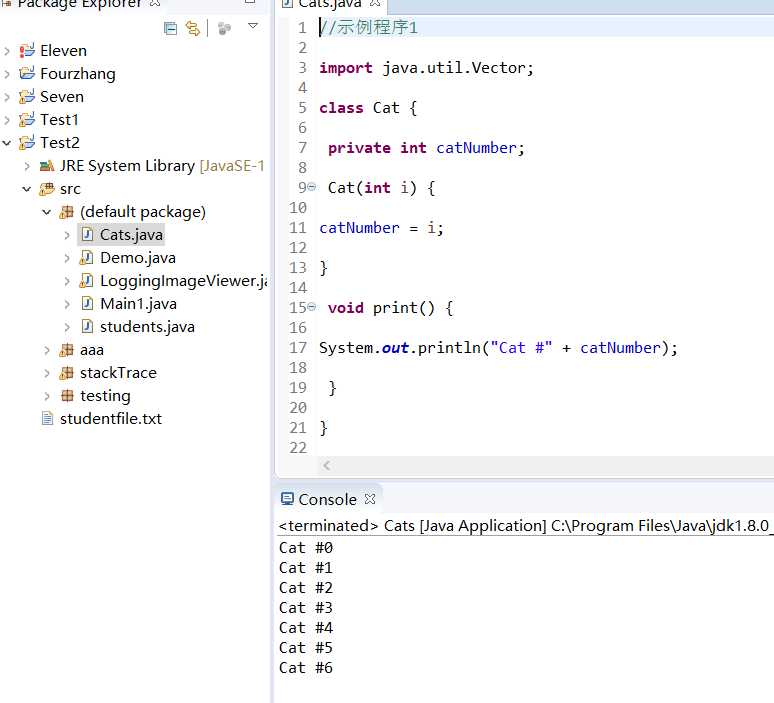
在命令行上面运行的结果如图:
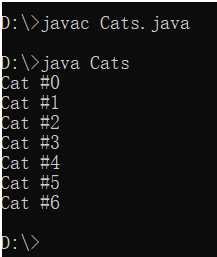
//示例程序2
import java.util.*;
public class Stacks
{
static String[] months={"金","银","铜","铁"};
public static void main(String[] args){
Stack<String> stk = new Stack<String> ();
for(int i=0; i<months.length; i++)
stk.push(months[i]);
System.out.println(stk);
System.out.println("element 2=" + stk.elementAt(2));
while(!stk.empty())
System.out.println(stk.pop());
}
}
示例二运行结果:
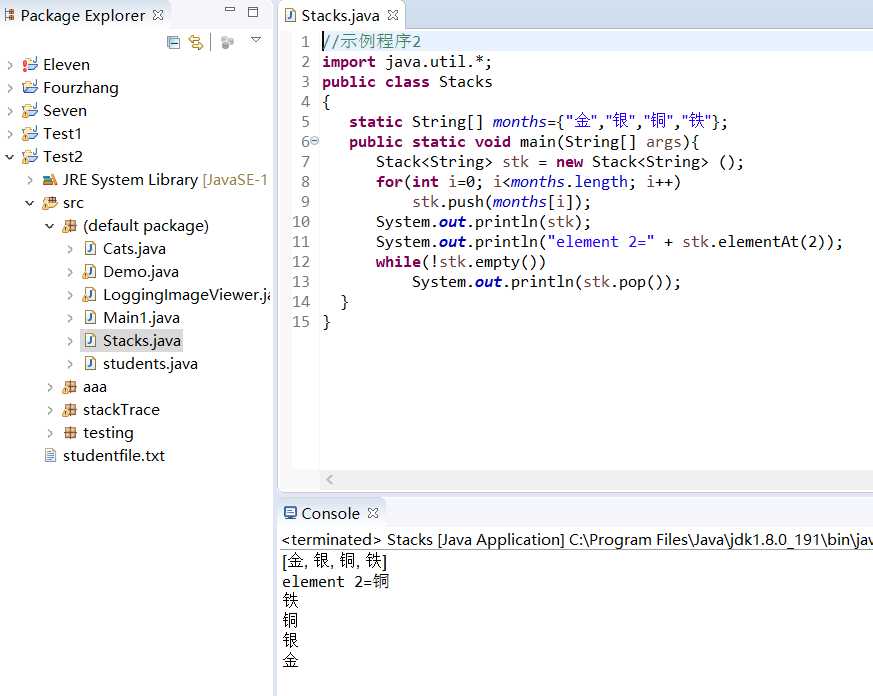
在命令行上面运行的结果如图:
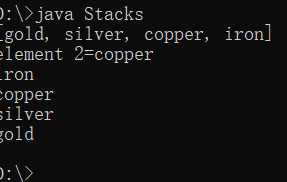
//示例程序3
import java.util.*;
class Counter {
int i = 1;
public String toString() {
return Integer.toString(i);
}
}
public class Statistics {
public static void main(String[] args) {
Hashtable ht = new Hashtable();
for (int i = 0; i < 10000; i++) {
Integer r = new Integer((int) (Math.random() * 20));
if(ht.containsKey(r))
((Counter)ht.get(r)).i++;
else
ht.put(r, new Counter());
}
System.out.println(ht);
}
}
示例三的运行结果:

在命令行上面运行的结果如图:

测试程序2:
l 使用JDK命令编辑运行ArrayListDemo和LinkedListDemo两个程序,结合程序运行结果理解程序;
|
import java.util.*;
public class ArrayListDemo { public static void main(String[] argv) { ArrayList al = new ArrayList(); // Add lots of elements to the ArrayList... al.add(new Integer(11)); al.add(new Integer(12)); al.add(new Integer(13)); al.add(new String("hello")); // First print them out using a for loop. System.out.println("Retrieving by index:"); for (int i = 0; i < al.size(); i++) { System.out.println("Element " + i + " = " + al.get(i)); } } } |
|
import java.util.*; public class LinkedListDemo { public static void main(String[] argv) { LinkedList l = new LinkedList(); l.add(new Object()); l.add("Hello"); l.add("zhangsan"); ListIterator li = l.listIterator(0); while (li.hasNext()) System.out.println(li.next()); if (l.indexOf("Hello") < 0) System.err.println("Lookup does not work"); else System.err.println("Lookup works"); } } |
import java.util.*;
public class ArrayListDemo {
public static void main(String[] argv) {
ArrayList al = new ArrayList();
// Add lots of elements to the ArrayList...
al.add(new Integer(11));
al.add(new Integer(12));
al.add(new Integer(13));
al.add(new String("hello"));
// First print them out using a for loop.
System.out.println("Retrieving by index:");
for (int i = 0; i < al.size(); i++) {
System.out.println("Element " + i + " = " + al.get(i));
}
}
}
其上述代码的运行结果:
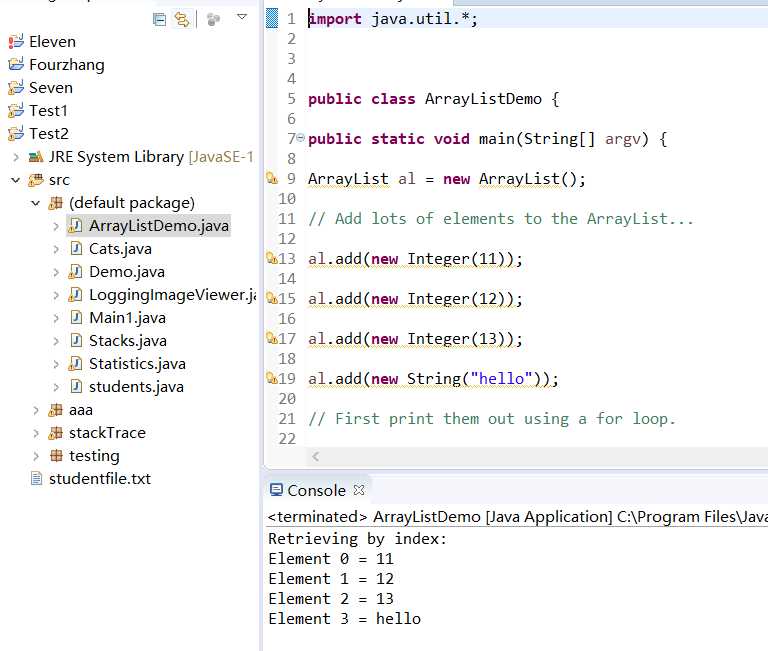
在命令行上面运行的结果如图:
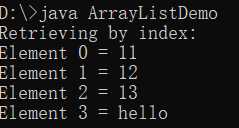
import java.util.*;
public class LinkedListDemo {
public static void main(String[] argv) {
LinkedList l = new LinkedList();
l.add(new Object());
l.add("Hello");
l.add("zhangsan");
ListIterator li = l.listIterator(0);
while (li.hasNext())
System.out.println(li.next());
if (l.indexOf("Hello") < 0)
System.err.println("Lookup does not work");
else
System.err.println("Lookup works");
}
}
其运行结果:
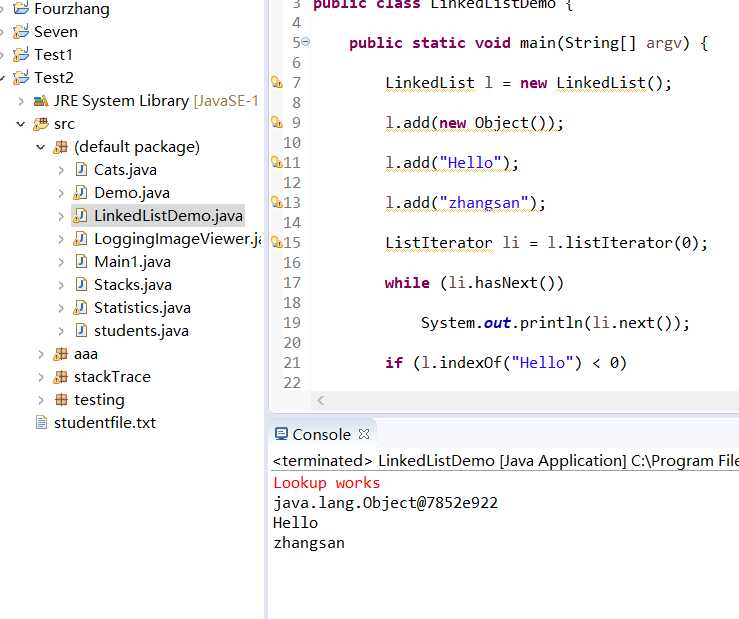
在命令行上面运行的结果如图:
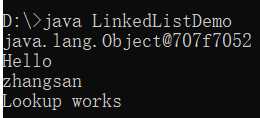
l 在Elipse环境下编辑运行调试教材360页程序9-1,结合程序运行结果理解程序;
l 掌握ArrayList、LinkList两个类的用途及常用API。
9-1 代码:
package linkedList;
import java.util.*;
/**
* This program demonstrates operations on linked lists.
* @version 1.12 2018-04-10
* @author Cay Horstmann
*/
public class LinkedListTest
{
public static void main(String[] args)
{
LinkedList<String> a = new LinkedList<String>();
a.add("Amy");
a.add("Carl");
a.add("Erica");
LinkedList<String> b = new LinkedList<String>();
b.add("Bob");
b.add("Doug");
b.add("Frances");
b.add("Gloria");
// merge the words from b into a
ListIterator<String> aIter = a.listIterator();
Iterator<String> bIter = b.iterator();
while (bIter.hasNext())
{
if (aIter.hasNext()) aIter.next();
aIter.add(bIter.next());
}
System.out.println(a);
// remove every second word from b
bIter = b.iterator();
while (bIter.hasNext())
{
bIter.next(); // skip one element
if (bIter.hasNext())
{
bIter.next(); // skip next element
bIter.remove(); // remove that element
}
}
System.out.println(b);
// bulk operation: remove all words in b from a
a.removeAll(b);
System.out.println(a);
}
}
运行结果:
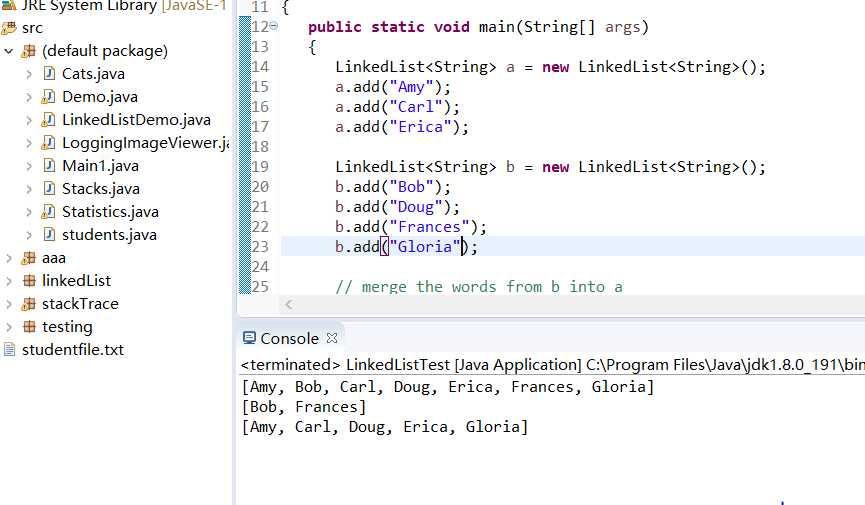
LinkedList类
LinkedList实现了List接口,允许null元素。此外LinkedList提供额外的get,remove,insert方法在 LinkedList的首部或尾部。这些操作使LinkedList可被用作堆栈(stack),队列(queue)或双向队列(deque)。
注意LinkedList没有同步方法。如果多个线程同时访问一个List,则必须自己实现访问同步。一种解决方法是在创建List时构造一个同步的List:
实验2:导入第10章示例程序,测试程序并进行代码注释。
测试程序1:
l 运行下列程序,观察程序运行结果。
|
import javax.swing.*; public class SimpleFrameTest { public static void main(String[] args) { JFrame frame = new JFrame(); frame.setBounds(0, 0,300, 200); frame.setDefaultCloseOperation(JFrame.EXIT_ON_CLOSE); frame.setVisible(true); } } |
import javax.swing.*;
public class SimpleFrameTest
{
public static void main(String[] args)
{
JFrame frame = new JFrame();
frame.setBounds(0, 0,300, 200);
frame.setDefaultCloseOperation(JFrame.EXIT_ON_CLOSE);
frame.setVisible(true);
}
}
运行结果:
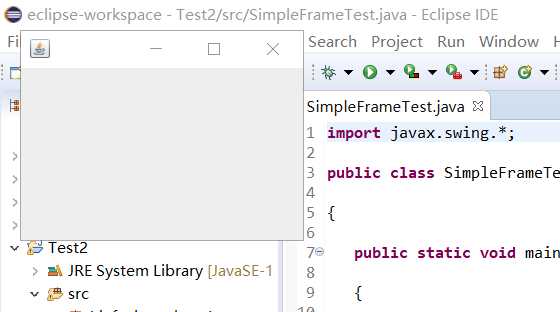
l 在elipse IDE中调试运行教材407页程序10-1,结合程序运行结果理解程序;与上面程序对比,思考异同;
l 掌握空框架创建方法;
l 了解主线程与事件分派线程概念;
l 掌握GUI顶层窗口创建技术。
10-1 代码:
package simpleFrame;
import java.awt.*;
import javax.swing.*;
/**
* @version 1.34 2018-04-10
* @author Cay Horstmann
*/
public class SimpleFrameTest
{
public static void main(String[] args)
{
EventQueue.invokeLater(() ->
{
SimpleFrame frame = new SimpleFrame();
frame.setDefaultCloseOperation(JFrame.EXIT_ON_CLOSE);//设置窗口是否可控
frame.setVisible(true);//设置窗口是否可见
});
}
}
class SimpleFrame extends JFrame
{
private static final int DEFAULT_WIDTH = 300;
private static final int DEFAULT_HEIGHT = 200;
public SimpleFrame()
{
setSize(DEFAULT_WIDTH, DEFAULT_HEIGHT);
}
}
其运行结果:
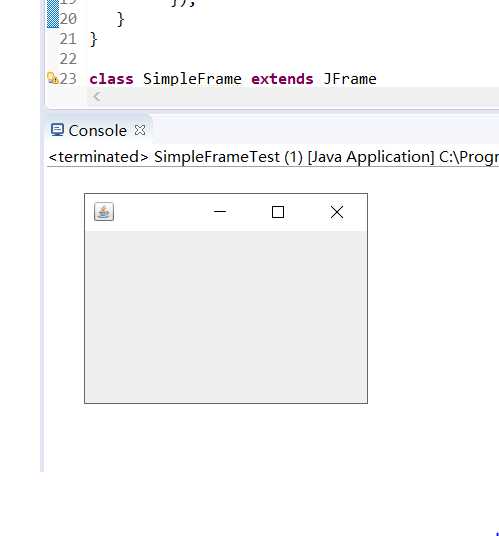
测试程序2:
l 在elipse IDE中调试运行教材412页程序10-2,结合运行结果理解程序;
l 掌握确定框架常用属性的设置方法。
10-2 代码:
package sizedFrame;
import java.awt.*;
import javax.swing.*;
/**
* @version 1.35 2018-04-10
* @author Cay Horstmann
*/
public class SizedFrameTest
{
public static void main(String[] args)
{
EventQueue.invokeLater(() ->
{
SizedFrame frame = new SizedFrame();
frame.setTitle("SizedFrame");//设置窗口的尺寸
frame.setDefaultCloseOperation(JFrame.EXIT_ON_CLOSE);//设置窗口是否可控
frame.setVisible(true);//设置窗口是否可见
});
}
}
class SizedFrame extends JFrame
{
public SizedFrame()
{
// get screen dimensions
Toolkit kit = Toolkit.getDefaultToolkit();
Dimension screenSize = kit.getScreenSize();
int screenHeight = screenSize.height;
int screenWidth = screenSize.width;
// set frame width, height and let platform pick screen location
//设置框架 宽度,高度,病并让平台拾取屏幕位置
setSize(screenWidth / 2, screenHeight / 2);
setLocationByPlatform(true);
// set frame icon
Image img = new ImageIcon("icon.gif").getImage();
setIconImage(img);
}
}
运行结果:
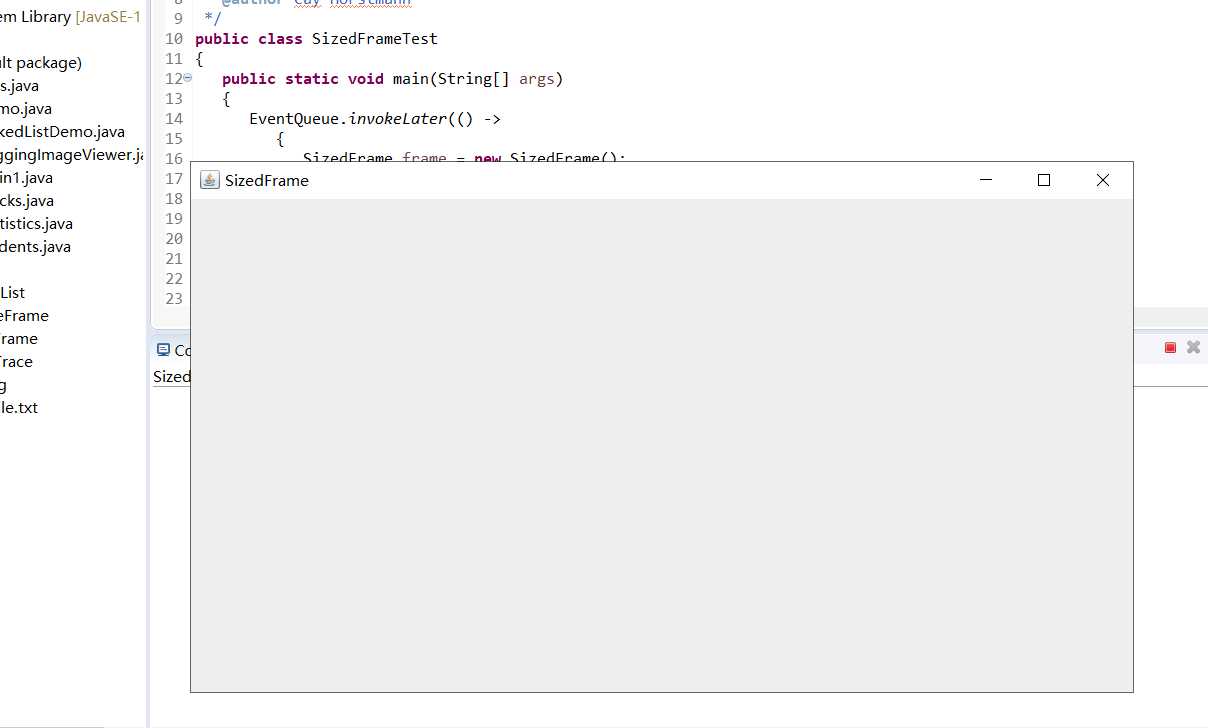
测试程序3:
l 在elipse IDE中调试运行教材418页程序10-3,结合运行结果理解程序;
l 掌握在框架中添加组件;
掌握自定义组件的用法。
10-3 代码:
package notHelloWorld;
import javax.swing.*;
import java.awt.*;
/**
* @version 1.34 2018-04-10
* @author Cay Horstmann
*/
public class NotHelloWorld
{
public static void main(String[] args)
{
EventQueue.invokeLater(() ->
{
NotHelloWorldFrame frame = new NotHelloWorldFrame();
frame.setTitle("NotHelloWorld");//将此窗体的标题设置为指定的字符串。
frame.setDefaultCloseOperation(JFrame.EXIT_ON_CLOSE);//设置窗口是否可控
frame.setVisible(true);
});
}
}
/**
* A frame that contains a message panel.
*/
class NotHelloWorldFrame extends JFrame
{
public NotHelloWorldFrame()
{
add(new NotHelloWorldComponent());
pack();
}
}
/**
* A component that displays a message.//显示消息的组件
*/
class NotHelloWorldComponent extends JComponent
{
public static final int MESSAGE_X = 75;
public static final int MESSAGE_Y = 100;
private static final int DEFAULT_WIDTH = 300;
private static final int DEFAULT_HEIGHT = 200;
public void paintComponent(Graphics g)
{
g.drawString("Not a Hello, World program", MESSAGE_X, MESSAGE_Y);
}
public Dimension getPreferredSize()
{
return new Dimension(DEFAULT_WIDTH, DEFAULT_HEIGHT);
}
}
运行结果:
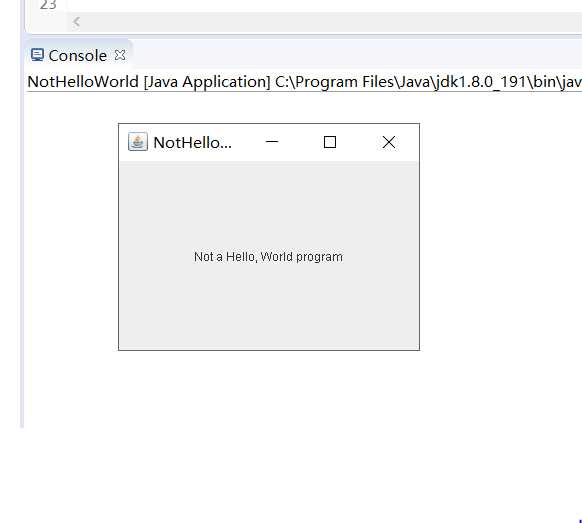
第三部分:实验总结
对如何创建框架,以及如何生成一个绘制图形的面板 ,以及如何在面板上绘制图形有了一定的了解,以及如何设置窗口中的字体,以及窗口的背景,还有字体大小字体颜色有了一定了解,通过对源码的查看,对如何设计窗口,以及窗口中的一些属性有了进一步的理解。
201871010101-陈来弟《面向对象程序设计(Java)》第十二周学习总结
标签:cin tostring key 添加组件 util code swing 开发 eve
原文地址:https://www.cnblogs.com/wing2438/p/11883369.html